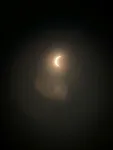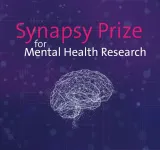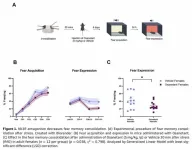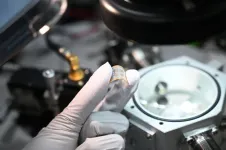(Press-News.org) A new study published today in Scientific Reports reveals how birds responded to the April 8, 2024, total solar eclipse across North America. The study finds bird vocalizations significantly declined only where more than 99% solar obscuration occurred. Researchers from Loggerhead Instruments, Inc. and the K. Lisa Yang Center for Conservation Bioacoustics at the Cornell Lab of Ornithology analyzed data from 344 community-based acoustic monitoring devices, called Haikuboxes, using a novel neural network approach. Unlike previous studies, this research controlled for human presence, recognizing that birds might react to the observers themselves, rather than the eclipse. This is the first major study to leverage the Haikubox network for scientific research.
“Anecdotal evidence has long suggested that birds fall silent or exhibit nighttime behaviors during a total solar eclipse,” said David Mann, PhD., lead author of the study and researcher at Loggerhead Instruments. “Our study shows that on average, birds do get quiet during and just after totality, but we also learned that this behavior is strongly linked to the degree of darkness experienced."
The research also revealed varied responses among different bird species, even for the same species at different locations. For example, Black-capped Chickadees at two sites reacted differently to the eclipse: at one site in New York State they were quiet until well after totality, while they increased their vocalizations during and immediately after peak totality at another site in Vermont. Other species and site variations were found: for example, one or more American Robins sang throughout totality at one site in Kentucky, while Pine Siskin vocalizations stopped completely during totality at another site in Maine.
“The variability in bird responses and site differences was fascinating,” said Mann. “We really don’t know why birds had such different responses to the total darkness during the eclipse. Despite examining factors like temperature, cloud cover, and wind speed, we found no significant relationship with changes in vocalization rates. This strongly suggests that the sudden total darkness and associated changes in wind and temperature were the primary drivers of the observed behavioral shifts.”
It is important to note that data from Haikuboxes with detectable human presence during the eclipse period were excluded to eliminate potential reactions to human presence. “Our first, quick look at Haikubox data just a few hours after the eclipse showed a large dip in bird vocalizations around the time of peak totality,” said Mann. “When we dove deeper into the data and removed any sites where humans may have influenced the birds’ behaviors, we found a much more complicated story. People were pretty excited about the total solar eclipse, and their celebrations likely affected the birds’ reactions.”
This study shows the research potential of a large, community science-powered, bioacoustic monitoring network. “In a time when technology often pulls us away from the natural world, Haikubox does the opposite – it fosters a deeper connection to it. By combining AI technology with a love for the environment, Haikubox helps people engage with nature in a modern and educational way,” notes Mann. The Haikubox network relies on community scientists (also sometimes referred to as citizen scientists) to host acoustic monitoring devices. It provides a unique platform for studying wildlife behavior across broad geographic areas without the biases associated with human observation.
“Our findings can inform future research on the impacts of light pollution and sudden changes in light levels on bird behavior, " notes Mann. “Furthermore, it proves that when we combine the power of community science with clever technology, we can learn amazing things about wildlife without disturbing them, which may inform future continental-scale studies." As one node in a growing passive acoustic monitoring network, Haikubox owners contribute valuable bird behavior data that can fuel future scientific research.
The study, published April 8, 2025, is titled “Continental-scale behavioral response of birds to a total solar eclipse.” In addition to Mann, it is co-authored by Austin Anderson, Amy Donner and Michael Hall of Haukubox; and Stefan Kahl and Holger Klinck of the K. Lisa Yang Center for Conservation Bioacoustics at the Cornell Lab of Ornithology. Haikubox was developed with support from the National Science Foundation (NSF)’s Small Business Innovation Research (SBIR) program.
The research team expects this is the first of many research projects to use Haikubox acoustic data. “Passive acoustic monitoring is a terrific tool for gathering data about animal behavior, and regular folks play an important role in widening our listening network,” said Mann. “Putting a Haikubox in your yard helps us add to the already 1 billion acoustic recordings we’ve gathered. Our community is enabling tomorrow’s scientific discoveries.”
About Haikubox
Haikubox is an AI-Enabled Wi-Fi-connected device that helps birdwatchers “bird by ear” by automatically identifying birds through their unique sounds, while also contributing valuable data to a community science network for ecological research. By fostering a deeper connection with nature through technology, Haikubox empowers users to effortlessly observe and record the beauty and seasonality of birds in their environment.
About Loggerhead Instruments, Inc:
Loggerhead Instruments, Inc. designs and manufactures environmental monitoring instruments and provides advanced technology solutions for ecological research.
About the Cornell Lab of Ornithology:
The Cornell Lab of Ornithology is a world leader in the study and conservation of birds; its K. Lisa Yang Center for Conservation Bioacoustics uses sounds in nature to inform and advance the conservation of wildlife habitats.
About David Mann, Ph.D/Founder of Haikubox
David Mann, Haikubox founder, was a young birder who spent hours in his neighborhood and at nearby Sapsucker Woods at Cornell University searching for birds. He later studied biology at Cornell and earned a PhD from MIT and the Woods Hole Oceanographic Institution focused on bioacoustics. When David and long-time colleague Holger Klinck, PhD, Director of the K. Lisa Yang Center for Conservation Bioacoustics at the Cornell Lab of Ornithology, realized they shared a common interest and the technical skills to develop an automatic birdsong identification tool, Haikubox was hatched.
END
Eclipse echoes: groundbreaking study reveals surprising avian vocal patterns during solar eclipse
Published in Scientific Reports, Haikubox community science study finds significant bird song decline only where more than 99% solar obscuration occurred
2025-04-08
ELSE PRESS RELEASES FROM THIS DATE:
Mirvie announces results from largest molecular study in pregnancy and clinical validation of simple blood test to predict risk for preeclampsia months before symptoms
2025-04-08
South San Francisco, CA (April 8, 2025) - Today, Mirvie announced results of a breakthrough study published in Nature Communications, revealing new advances in the biological understanding of hypertensive disorders of pregnancy (HDP), including preeclampsia - a leading cause of maternal morbidity and mortality as well as preterm birth. Researchers used data from more than 9,000 pregnancies within the multi-center Mirvie-sponsored Miracle of Life prospective study to discover and validate RNA signatures capable of distinguishing between severe and mild hypertensive disorders of pregnancy, including preeclampsia, months before ...
Eating only during the daytime could protect people from heart risks of shift work
2025-04-08
A study led by researchers at Mass General Brigham suggests that, when it comes to cardiovascular health, food timing could be a bigger risk factor than sleep timing
Numerous studies have shown that working the night shift is associated with serious health risks, including to the heart. However, a new study from Mass General Brigham suggests that eating only during the daytime could help people avoid the health risks associated with shift work. Results are published in Nature Communications.
“Our prior research has shown that circadian misalignment – the mistiming of our behavioral cycle relative to our internal body clock – increases cardiovascular risk factors,” ...
Discovery of mitochondrial protein by researchers at Lewis Katz School of Medicine at Temple University opens path to therapeutic advances for heart and Alzheimer’s disease
2025-04-08
(Philadelphia, PA) – Calcium transport into and out of mitochondria – the powerhouses of cells – is central to cellular energy production and cell death. To maintain the balance of calcium within these powerhouses, cells rely on a protein known as the mitochondrial sodium-calcium exchanger, or NCLX. Now, in new research, scientists at the Lewis Katz School of Medicine at Temple University have discovered a novel regulator of NCLX activity, a protein called TMEM65, which helps move ...
Recognizing the bridge builders between neuroscience and psychiatry
2025-04-08
Mental health is in crisis worldwide. While the neurosciences are advancing rapidly, psychiatry still struggles to diagnose and effectively treat many disorders. The Synapsy Center for Neuroscience and Mental Health Research at the University of Geneva, Switzerland, is launching a new international prize to reward those who bring these two worlds closer together.
A new research model is needed
Depression, schizophrenia, anxiety or bipolar disorders: psychiatric illnesses affect hundreds of millions of people worldwide and are among the leading causes of disability, suffering and mortality. Yet clinical advances remain limited. Many diagnoses ...
Lactic acid bacteria can improve plant-based dairy alternatives
2025-04-08
A new study maps how specific lactic acid bacteria can enhance both the flavour and nutritional quality of plant-based dairy alternatives. The findings may have wide-reaching perspectives for the further development of sustainable foods.
Plant-based dairy alternatives – such as soy, oat, and almond drinks – are produced without animal ingredients for consumers seeking plant-based substitutes for milk and yoghurt. However, many of these products have the similar shortcomings: flavours that do not always appeal ...
Public housing smoking ban reduced heart attacks and strokes
2025-04-08
A new paper in Nicotine & Tobacco Research, published by Oxford University Press, finds that a 2018 U.S. ban on smoking in public housing led to a reduction in hospitalizations for cardiovascular problems.
Tobacco use and exposure to secondhand smoke is a leading cause of preventable death in the United States. Some 480,000 Americans die every year due to tobacco. While the prevalence of adults exposed to secondhand smoke decreased dramatically between 1988 and 2014 (from 87.5% to 25.2%), about 58 million non-smokers in the U.S. experience tobacco smoke, primarily at home. Beginning in the early 2000s, ...
Positron emission tomography in psychiatry: Dr. Romina Mizrahi maps the molecular future
2025-04-08
MONTRÉAL, Québec, Canada, 8 April 2025 – In a powerful and deeply reflective Genomic Press Interview, published in Brain Medicine, Dr. Romina Mizrahi, Professor of Psychiatry at McGill University and Principal Investigator of the CaTS (Clinical and Translational Sciences) Lab at the Douglas Research Center, charts a new path forward in psychiatric research—one that begins at the molecular level.
Harnessing the power of positron emission tomography (PET), Dr. Mizrahi’s work sheds light on the invisible workings of the human brain. Where traditional psychiatric diagnosis often relies on subjective symptom clusters, her approach integrates in-vivo imaging, ...
Post-trauma drug blocks fear response in female mice, study shows
2025-04-08
BARCELONA, Catalonia, Spain, 8 April 2025 – A new Brevia (peer-reviewed research report) published in Brain Medicine reveals that a single dose of the drug Osanetant, administered shortly after a traumatic event, significantly dampens fear expression in female mice. The findings provide strong preclinical support for using Nk3R antagonism as a sex-specific, time-sensitive intervention to reduce the risk of posttraumatic stress disorder (PTSD).
Targeting fear memory at its roots
Fear memory is a core feature of PTSD, especially when neutral cues become emotionally ...
Trees could be spying on illegal gold mining operations in the Amazon rainforest
2025-04-08
For hundreds of years, the Amazon has been exploited for its gold. Today, the precious metal is just as sought after, but the remaining tiny gold particles are much harder to find. Mining often happens in artisanal and small-scale mining operations that release mercury (Hg) into the air, polluting the environment and harming human health.
An international team of researchers has now examined tree rings of species native to the Peruvian Amazon to determine if trees could be used to show approximately where and when atmospheric mercury was released.
“We show that Ficus insipda tree cores can be used as a biomonitor for characterizing ...
Even after a thousand bends, performance remains uncompromised!
2025-04-08
The research team led by Dr. Jongwon Yoon, Dr. Jeongdae Kwon, and Dr. Yonghoon Kim from the Energy & Environmental Materials Research Division at the Korea Institute of Materials Science (KIMS), has successfully developed the world’s first ammonia (NH₃) gas sensor based on a copper bromide (CuBr) film that can be fabricated through a simple solution process at low temperatures. This breakthrough technology not only enables sensor flexibility, ultra-sensitivity, and high selectivity but also significantly reduces manufacturing costs.
Ammonia gas sensors detect airborne ammonia and are utilized in indoor and outdoor ...
LAST 30 PRESS RELEASES:
Scalable and healable gradient textiles for multi‑scenario radiative cooling via bicomponent blow spinning
Research shows informed traders never let a good climate crisis go to waste
Intelligent XGBoost framework enhances asphalt pavement skid resistance assessment
Dual-function biomaterials for postoperative osteosarcoma: Tumor suppression and bone regeneration
New framework reveals where transport emissions concentrate in Singapore
NTP-enhanced lattice oxygen activation in Ce-Co catalysts for low-temperature soot combustion
Synergistic interface engineering in Cu-Zn-Ce catalysts for efficient CO2 hydrogenation to methanol
COVID-19 leaves a lasting mark on the human brain
Scientists use ultrasound to soften and treat cancer tumors without damaging healthy tissue
Community swimming program for Black youth boosts skills, sense of belonging, study finds
Specific depressive symptoms in midlife linked to increased dementia risk
An ‘illuminating’ design sheds light on cholesterol
Who is more likely to get long COVID?
Study showcases resilience and rapid growth of “living rocks”
Naval Research Lab diver earns Office of Naval Research 2025 Sailor of the Year
New Mayo-led study establishes practical definition for rapidly progressive dementia
Fossil fuel industry’s “climate false solutions” reinforce its power and aggravate environmental injustice
Researchers reveal bias in a widely used measure of algorithm performance
Alcohol causes cancer. A study from IOCB Prague confirms damage to DNA and shows how cells defend against it
Hidden viruses in wastewater treatment may shape public health risks, study finds
Unlock the power of nature: how biomass can transform climate mitigation
Biochar reshapes hidden soil microbes that capture carbon dioxide in farmland
Reducing saturated fat intake shows mortality benefit, but only in high-risk individuals
Manta rays create mobile ecosystems, study finds
Study: Mixed results in using lipoic acid to treat progressive multiple sclerosis
Norbert Holtkamp appointed director of Fermi National Accelerator Laboratory
New agentic AI platform accelerates advanced optics design
Biologists discover neurons use physical signals — not electricity — to stabilize communication
Researchers discover that a hormone can access the brain by hitchhiking
University of Oklahoma researcher awarded funding to pursue AI-powered material design
[Press-News.org] Eclipse echoes: groundbreaking study reveals surprising avian vocal patterns during solar eclipsePublished in Scientific Reports, Haikubox community science study finds significant bird song decline only where more than 99% solar obscuration occurred






